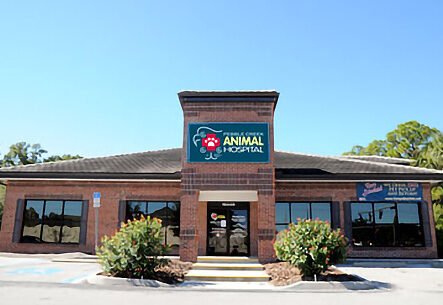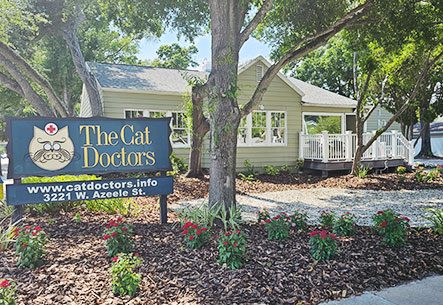Hamsters
What to expect from your Hamster
Hamsters are small, appealing pets that adapt well to captivity. They do not require a lot of living space and are relatively inexpensive to maintain. With frequent, gentle handling a hamster can easily become tame. However, they are nocturnal animals and will not tolerate being held still for long. Hamsters may bite or show aggression in response to rough handling, sudden disturbances, being around other hamsters (especially female hamsters that are pregnant or lactating), or when they are ill or in pain.
To hold your hamster, care must be taken to maintain gentle control and prevent being bitten. They can be scruffed by the abundant loose skin at the nape of the neck, held in the hands (if friendly), or placed in a small container. A small cloth may help restrain the rodent without the handler being bitten.
A unique characteristic of hamsters is the presence of cheek pouches, which are used to store and transport food to the hamster’s burrow. Similar to other species of rodents, hamsters have four incisor teeth, which grow throughout life. For tooth health, it is important to provide a good diet and to offer safe items in the enclosure for the hamster to chew.
Vital Statistics
- Average adult body weight: Males: 80-130 g, Female: 95-150 g
- Age of sexual maturity: Male: 10-14 weeks, Female: 6-10 weeks
- Average life span in captivity: 1.5-2 years
Is your Hamster a male or a female?
Male hamsters have rather large scrotal sacs that give them a rounded posterior. Gentle pressure on the abdomen of the male hamster will cause the testicles to descend into the sacs. The female hamster’s posterior is pointed toward the tail.
What do Hamsters do all day?
Syrian golden hamsters should be housed individually in an enclosure. Hamsters are excellent climbers and burrowers and should be provided with safe outlets for these activities. They enjoy running in exercise wheels; however, only wheels with a solid running surface should be used to prevent limb trauma. A wire wheel can be modified to provide a solid surface for running. A wheel for an adult golden hamster should be at least 8” (20 cm) in diameter. If clear plastic exercise balls are used for the hamster to explore the home safely, the covers must be secured with tape to prevent the animal’s escape from the ball.
What should you feed your Hamster?
Hamsters should be fed commercial pellets specifically designed for small rodents. Young hamsters begin eating solid food at 7-10 days of age, so food and water must be accessible for their smaller size. Treats may include such items as tiny bits of apple (no seeds or skin), raisins and walnuts. Drinking water is provided via sipper tubes. The water should be changed daily to ensure that the tube is functional and not clogged with food. Water can also be obtained from carrots and other fruits and vegetables.
How to keep your Hamster healthy, happy and safe
- Set up a schedule of consistent time and attention each day to maintain tameness.
- Clean the enclosure environment at least weekly to reduce odors and check for food in hiding spots that was hoarded and left to spoil.
- Use a wheel with solid flooring or modify a wire wheel by weaving a paper material through the rungs to prevent leg damage.
- Ensure that droppings are normal firm pellets. Sticky or soft droppings may indicate diarrhea, while scant, smaller droppings may indicate constipation.
- Because free-ranging hamsters spend almost all daylight hours underground, exposure to direct sunlight in captivity is not desirable.
Housing for your hamster should:
- be made of strong metal to be escape-proof, as hamsters can gnaw through wood, plastic and soft metals.
- include a secure lid and solid-bottom flooring.
- offer at least 150 square inches (967 cm2) of floor space with a cage height of at least 6-10 inches (15-25 cm).
- include a nesting or hide box with deep litter for burrowing.
- be placed in optimum temperatures of 65-79 F, with young maintained between 71-75 F.
- provide relative humidity environment of 40-70%.
- contain a nesting material, such as undyed, unscented toilet tissue. The hamster will instinctively manipulate this to simulate the burrow, and it helps the hamster control temperature.
It is important to prevent hamsters from accessing:
- electrical cords
- dogs, cats, ferrets and young children
- pesticides and other toxins
- tobacco and cigarette smoke
- cedar or pine shavings
- toxic houseplants
- wire exercise wheels
- wire flooring in its enclosure
- fatty seed diets, too much fresh produce, not enough fiber, too many treats
- plastic toys that can be broken apart and consumed
- commercial wooden chew blocks, chew sticks and common household sources of wood that may be contaminated with fireproofing material
- nesting materials (commonly called fluff) that may lead to intestinal blockages or strangulated limbs.
What your veterinarian looks for in a healthy Hamster:
- Bright, shiny eyes
- Nose and eyes clear of any discharge
- Nails and teeth not overgrown
- Males have normal scent glands (dark patches on their flanks)
- Hair coat in good condition (no hair loss or greasy or unkempt appearance)
Most common disorders of Hamsters:
- Obesity/weight loss
- Diarrhea (transitory)
- Wet tail/gastrointestinal disturbances
- Skin wounds/trauma
- Skin infections
- Excess urination
- Sudden death
- Malocclusion/ cheek pouch impaction
- Malnutrition/starvation/dehydration
- Hairballs/foreign bodies
- Chilling/overheating
- Litter abandonment
- Antibiotic toxicity
- Heart disease
Having your hamster examined on a regular basis by an exotic animal veterinarian who is familiar with small exotic mammals can prevent many of the common disorders above.
Background information
The most common hamster species maintained as a pet is the golden or Syrian hamster (Mesocricetus auratus). Others include the Chinese hamster (Cricetulus griseus) and Siberian (dwarf winter white or Djungarian) hamster (Phodopus sungorus). The European or black-bellied hamster (Cricetus cricetus) is not usually kept domestically. The golden hamster originates from a very limited range in the Middle East, where owl predators and destruction of territory are threatening the species’ existence. Today, captive breeding facilities supply the pet and research laboratory markets.
Courtesy of Zoological Education Network
Tampa, FL 33615 (View map)
Tampa, FL 33647 (View map)
Tampa, FL 33617 (View map)
Tampa, FL 33647 (View map)








